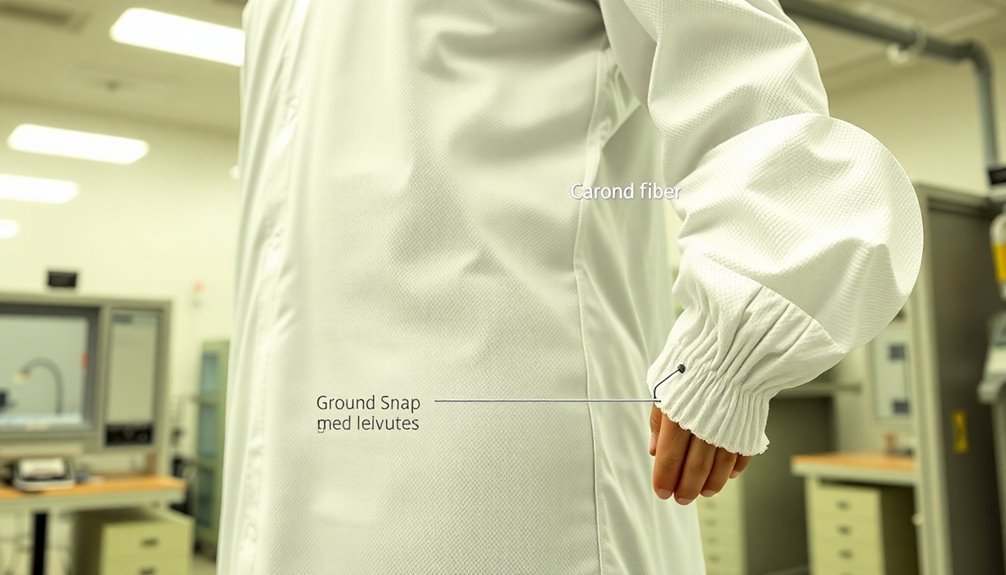Electronics manufacturers need specialized ESD (electrostatic discharge) protective clothing to prevent static damage to sensitive components. You'll need garments made with conductive yarns and dissipative fabrics that meet ANSI/ESD S20.20 standards. Basic requirements include smocks or coveralls with proper grounding capabilities through snaps or cuffs, maintaining resistance below 35 megohms when connected to ground. Your clothing should form a complete Faraday Cage, using materials like carbon-infused polyester or cotton blends. While basic static control garments work for some tasks, you'll find different protection levels available to match your specific manufacturing needs.
Understanding Static Control Garment Categories

While protecting sensitive electronic components from electrostatic discharge (ESD) is essential, manufacturers must understand the three distinct categories of static control garments to choose the right protection level.
Category 1 garments don't require grounding and work by making contact with your skin to suppress static. They shield your clothing from ESD-sensitive products and rely on your primary ground source. However, charges may build up on conductive elements if they're not touching your skin. Regular point-to-point testing helps verify these garments maintain proper functionality.
These garments must maintain resistance below 1 x 10^11 ohms.
Category 2 garments offer enhanced protection through optional grounding. You'll need a ground cord for effective static control, but don't rely on these garments as your primary ground source – you'll still need a wrist strap or heel grounders.
These garments feature resistance below 1 x 10^9 ohms.
Category 3 garments represent the most thorough solution, functioning as both a primary ground source and clothing shield. They require good skin contact and often use ESD cuffs.
The total system resistance, including your body, garment, and grounding cord, must stay below 35 megohms. You'll typically find these in sensitive environments like microelectronics manufacturing facilities.
Essential ESD Clothing Components
Through carefully selected materials and construction techniques, ESD protective clothing relies on several essential components to effectively control static discharge.
You'll find that conductive yarns are woven into fabrics in precise grid patterns, with spacing no greater than 10mm to guarantee consistent static dissipation. These patterns work together with polyester and cotton materials that contain embedded carbon fibers to create a protective Faraday Cage effect around your body.
When selecting ESD garments, you'll need to guarantee they meet ANSI ESD S20.20 standards, which require surface resistivity less than 1 x 10^11 ohms resistance. Static discharge controls are vital for preventing costly repairs and product failures.
The essential components must work together to provide thorough protection:
- Conductive fiber grid patterns that maintain consistent spacing throughout the garment
- Carbon-infused base materials that provide the foundation for static control
- Specialized seam construction that maintains conductivity across fabric joints
- Grounding points that connect to wrist straps or heel grounders
- Durable conductive yarns that withstand repeated washing cycles
These components create an integrated system that protects sensitive electronic components while maintaining comfort and functionality for daily wear in manufacturing environments.
Grounding Systems and Requirements

You'll need to understand three key grounding standards when working with static-control clothing:
ANSI/ESD STM97.1 requires less than 1.0 x 10^9 ohms resistance to ground,
while ANSI/ESD STM97.2 mandates body voltage below 100 volts during walking tests.
Your personnel grounding options include Earth-Rite systems with LED indicators,
These systems feature continuous resistance monitoring through high-intensity LED displays that verify proper grounding connections.
Bond-Rite continuous monitoring systems, and Cen-Stat ATEX-approved clamps,
all of which must maintain resistance levels below 35 megohms for Category 3 garments.
Grounding Tests and Standards
Thorough grounding tests and standards form the backbone of reliable ESD protection in static-control clothing. You'll need to verify electrical conductivity through all garment panels and confirm compliance with international standards like EN ISO 1149 and ASTM D6413. These standards define specific requirements for anti-static clothing conductivity, durability, and safety performance. The surface resistance requirement for antistatic clothing must measure less than 2.5 x 10^(9) ohms.
When testing ESD garments, you'll want to focus on these critical parameters:
- Peak current measurements to assess charge dissipation
- Charge transfer capabilities across all garment surfaces
- External field control effectiveness
- Electrical resistance through conductive components
- Continuous monitoring of shielding capabilities
Your testing procedures should align with recommendations from IEC TC101 and ESTAT Garments project guidelines. These organizations provide detailed frameworks for evaluating static-control clothing in electronics manufacturing environments.
You'll need to document test results showing your garments can effectively prevent static build-up and dissipate charges safely. Remember that certification requires evaluation by accredited bodies, who'll verify your garments meet all necessary standards.
This rigorous testing confirms your static-control clothing provides reliable protection for sensitive electronic components.
Personnel Grounding System Types
Personnel grounding systems serve as the first line of defense against electrostatic discharge in electronics manufacturing. You'll need to implement multiple grounding methods to guarantee thorough protection for your workers and sensitive electronic components.
Your primary grounding options include wrist straps connected to common ground points and static control garments. Regular testing and maintenance of these systems is essential to prevent differences in electrical potential. For enhanced protection, you'll want to think about ESD Category 2 garments, which provide superior electric field suppression when properly grounded.
If you're working with highly sensitive components, upgrade to ESD Category 3 garments that create a complete groundable system with less than 35 megohms of total resistance.
Don't forget to pair these garments with conductive footwear, particularly in clean room environments. You'll need to connect all personnel grounding systems to properly designed grounding electrodes that meet NEC Article 250 requirements.
Install your grounding system using multiple electrodes to achieve the lowest possible resistance. Remember to use dissipative work mats at each workstation and guarantee they're connected to your facility's common ground point.
This thorough approach creates multiple paths for static discharge, protecting both your workers and valuable electronic components.
Resistance Threshold Requirements
Maintaining proper resistance thresholds stands as a critical requirement for effective static-control clothing and grounding systems. You'll need to guarantee your static-control garments meet the ESD Category 3 requirements, which specify a total system resistance of less than 35 megohms from the person through the garment to the grounding point. This requirement ensures effective suppression of electric fields and maintains proper grounding throughout your manufacturing processes.
A current limiting resistor is incorporated into the system to ensure electrical safety of personnel. Your static-control clothing and grounding systems must meet these specific standards:
- All groundable static control garments must provide consistent low resistance paths to ground
- Conductive fabrics must maintain low resistance properties for effective grounding
- Grounding points must establish continuous paths to earth
- Systems must handle environmental variables like humidity and temperature changes
- All components must comply with ESD Association standards and guidelines
You'll need to implement regular testing protocols to verify your clothing's resistance remains within specified limits. The performance of your grounding system depends on proper maintenance and monitoring of all components, including grounding clamps and cables.
Remember that environmental conditions can affect your system's effectiveness, so you'll want to account for these variables in your testing and maintenance schedules.
Standards for Protective Wear
Standards governing protective wear in electronics manufacturing guarantee consistent safety across the industry through specific electrical resistance and material requirements. To protect sensitive electronic components from ESD damage, you'll need clothing that meets EN 1149-1 or IEC 61340-5-1 standards, with surface resistance below 2.5 x 10^9 ohms.
| Requirement Type | Specification |
|---|---|
| Surface Resistance | <2.5 x 10^9 ohms |
| Humidity Range | 30-70% RH |
| Grounding Resistance | <35 megohms |
| Material Type | Conductive/blended fibers |
Your protective wear must incorporate conductive fibers that won't break down over time, guaranteeing consistent static dissipation. Using antistatic synthetic fibers in the manufacturing process ensures reliable protection against electrical discharge. You'll find most ESD garments use blended fabrics with stainless steel or other conductive fibers that automatically discharge static buildup. When wearing these garments, you must guarantee proper grounding through wrist straps or dedicated ground cords connected to identified groundable points.
Remember that you can't rely on protective clothing alone. You'll need to maintain appropriate environmental conditions, particularly humidity levels between 30% and 70%. In low-humidity situations, you may need supplementary measures like air ionizers or humidifiers to maintain effective static control.
Testing ESD Garment Performance

Regular testing of your ESD garments using an ESD meter kit helps verify they maintain their protective qualities throughout their service life.
You'll need to perform both resistance point-to-point (RTT) and resistance-to-ground (RTG) measurements across garment panels, making sure values stay below 1.0×10^11 ohms to meet minimum requirements.
For accurate readings, always place the garment on an insulative surface with panels laid flat, and use insulative sleeve inserts to prevent fabric sides from touching during testing.
Daily Testing Best Practices
Testing ESD garments demands a systematic approach to guarantee consistent protection against electrostatic discharge in electronics manufacturing.
You'll need to perform point-to-point testing using ESD STM 2.1 methods, guaranteeing garments maintain resistance values between 1.0 x 10^5 and 1.0 x 10^11 Ohms. Test the garments while they're in use, paying special attention to seam integrity and overall performance across the fabric.
Your daily testing protocol should include these critical elements:
- Evaluate garments using established qualification parameters and point-to-point testing methods
- Check resistance values across all seams and critical areas of the garment
- Inspect for physical damage or wear that might compromise static control properties
- Verify proper grounding system functionality when garments are worn
- Document test results for compliance and tracking purposes
When conducting your tests, consider environmental factors like humidity, which can affect charge migration through undergarments. If you're using reusable ESD garments, you'll need to validate your laundry service provider and guarantee proper maintenance procedures are followed.
Remember that modern ESD garments may require testing beyond traditional resistance-based methods, so stay current with emerging evaluation techniques recommended by projects like ESTAT-Garments.
Measuring Garment Resistance Values
Measuring resistance values across your ESD garments requires precise equipment and standardized procedures to guarantee reliable protection. You'll need to follow ANSI/ESD STM2.1-2018 guidelines, which specify using 5-pound electrodes and proper voltage applications for accurate measurements.
To test your garments, place them on an insulative surface with sleeve inserts to prevent fabric sides from touching. Start by applying 10 volts for initial testing. If you measure resistance greater than 1.0 x 10^6 ohms, increase to 100 volts and maintain for at least 15 seconds.
You'll need to perform both point-to-point and point-to-groundable point measurements to verify compliance.
Your static control garments must measure less than 1 x 10^11 ohms for surface resistance point-to-point. If you're using groundable static control garments, they need to measure below 1 x 10^9 ohms. For complete groundable static control garment systems with a person wearing it and connected via wrist strap, verify that readings don't exceed 3.5 x 10^7 ohms.
Don't forget to test across seams and panels to verify uniform protection throughout the entire garment.
Key Features of Protection
Throughout the manufacturing of electronic components, static-control clothing relies on several critical protective features to safeguard both workers and sensitive devices. They are constructed with specialized materials like polyester or cotton embedded with conductive fibers, creating a Faraday Cage effect that dissipates static charges away from your body.
To guarantee maximum protection, you'll need garments that meet specific design and functionality requirements. They must maintain proper electrical bonding to your grounding system while featuring low tribocharging properties. You can verify this using a Static Field Meter, and you'll want to guarantee the clothing retains its antistatic properties even after multiple washes.
Key protective features you should look for include:
- Total system resistance below 35 megohms for Category 3 garments
- Conductive fibers integrated throughout the fabric
- Proper grounding methods via wrist straps or conductive cuffs
- Durable materials that maintain effectiveness after repeated use
- Extensive coverage to prevent exposure of personal clothing
When selecting static-control clothing, you'll need to guarantee compliance with industry standards like ESD TR20.20, while considering both safety requirements and efficiency needs in your manufacturing environment.
Selecting the Right ESD Clothing

When choosing ESD clothing for your electronics manufacturing facility, you'll need to navigate several critical selection criteria to guarantee maximum protection.
Start by checking that all garments meet IEC 61340-4-9:2016 and ANSI/ESD STM2.1:2018 standards, with resistance values below 1.0 x 10(11) ohms.
You'll want to select garments that contain at least 2% conductive carbon content and feature conductive fibers woven throughout the fabric.
Consider the specific needs of your facility – coveralls provide full-body protection, while smocks might suffice for upper-body coverage in electronics assembly. Don't forget essential accessories like gloves and boots to complete your protective ensemble.
Factor in comfort and proper fit, as these directly impact worker productivity.
You'll need to establish a testing and maintenance protocol that includes regular sleeve-to-sleeve and point-to-point testing. Pay attention to washing instructions, as improper cleaning can compromise the garment's effectiveness.
When selecting a supplier, look for brands that offer CE safety marks and certification from independent institutions. Choose manufacturers who provide a range of sizes and styles to accommodate your entire workforce while maintaining consistent protection levels across all garments.
Maintenance of Static Control Garments
Proper maintenance of your static control garments directly impacts their protective performance and longevity. You'll need to follow specific washing and drying guidelines to preserve the garments' ESD properties.
Use only cool or lukewarm water (max 40°C/104°F) and liquid detergent without bleach or fabric softeners, as harsh chemicals can damage the conductive components.
When it comes to drying, either hang your garments or use a low-heat tumble dry setting (max 50°C/120°F). Don't dry clean your ESD clothing, as this process can severely compromise its protective qualities.
Regular inspection and timely replacement are vital for maintaining effective static control.
Here are key maintenance practices you should follow:
- Wash garments using commercial laundry services that specialize in cleanroom or ESD procedures
- Monitor humidity levels and consider using humidifiers in dry environments to enhance dissipative properties
- Perform regular quality checks to identify signs of wear, particularly in areas prone to abrasion
- Avoid high-heat exposure during any part of the maintenance process
- Replace garments regularly according to manufacturer guidelines rather than waiting for visible deterioration
Remember that proper maintenance isn't just about cleanliness – it's about preserving the critical ESD protection your manufacturing process requires.
Cost Benefits of ESD Protection

Despite the initial investment, implementing effective ESD protection measures delivers substantial financial returns for electronics manufacturers.
ESD-related damage accounts for approximately 25% of unexplained electronic failures, contributing to an estimated $5 billion in annual industry losses. By investing in proper static-control clothing and equipment, you're effectively safeguarding your production process against these costly setbacks.
The cost-benefit analysis becomes even more compelling when you consider the long-term advantages. You're not just preventing immediate component damage; you're also reducing warranty claims, avoiding product recalls, and maintaining your competitive edge in markets that demand high reliability.
If you're manufacturing products for aerospace or medical industries, ESD protection isn't just cost-effective—it's essential for meeting strict industry standards.
Frequently Asked Questions
Can ESD Garments Be Shared Between Different Employees?
You shouldn't share ESD garments between employees. It's risky because sharing can compromise the garment's effectiveness, increase contamination risks, violate regulatory standards, and create hygiene concerns that could affect your manufacturing process.
How Often Should Static-Control Clothing Be Replaced?
You'll need to replace your static-control clothing every 6-12 months, depending on usage, washing frequency, and environmental conditions. Regular testing should guide your replacement schedule, especially if you notice reduced effectiveness.
Do Employees Need Multiple Sets of ESD Clothing?
You'll need multiple sets of ESD clothing to maintain continuous protection while washing and rotating garments. Having at least 3-4 sets guarantees you're always properly protected during your work shifts.
Is Static-Control Clothing Machine Washable at Home?
You can machine wash static-control clothing at home, but you'll need to follow strict guidelines: use neutral water, control temperatures for specific fabrics, and avoid fabric softeners to maintain the garment's anti-static properties.
Can ESD Garments Be Worn Outside Designated Static-Protected Areas?
You shouldn't wear ESD garments outside designated static-protected areas. It'll expose them to contaminants, compromise their effectiveness, and reduce their protective properties. Plus, you won't have proper grounding mechanisms available outside EPAs.
In Summary
You've learned that proper ESD clothing isn't optional in electronics manufacturing – it's essential for protecting sensitive components and your bottom line. Remember to select garments that meet industry standards, maintain them properly, and verify your grounding systems work effectively. When you invest in quality static-control clothing and follow proper protocols, you'll minimize costly damage and maximize production efficiency.





Leave a Reply